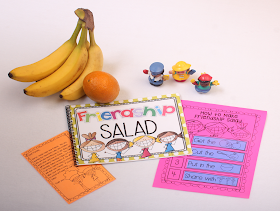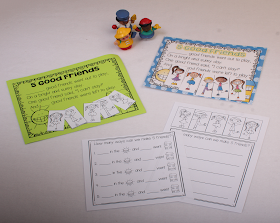Have you started back to school? It is 100 degrees outside, but school is back in session in Georgia! It seems the summer just started! While I miss those days of my girls and their babies hanging out by the pool, the smell of new crayons pulls us back to school. Those first few days are critical!
There are some simple things that we can remember when planning for the first weeks of school.
Establish Procedures
One of the easiest things to do is to have a catch phrase for getting their attention. This is the one that I use. It is best to stick to the same one so that the children know exactly what you want them to do when they hear it. Use the phrase a crazy number of times. Each time, praise and acknowledge children who are looking at you with their hands positioned in whatever position you direct. Consistent and constant!
Instead of having a "treasure chest" consider having a class reward system. Reward children for good citizenship by adding marbles to a jar. It's a win-win! At the beginning of the year reward often and consistently. This shows the children the expectations of the classroom. No need to buy them a reward. I'm sure you are doing really great activities in your room. Once the jar is full, reward the children with a great activity!
Teach your children many songs! There is a direct connect between music and brain growth. Music is actually one of the 20 strategies in Marcia Tayte's book Worksheets Don't Grow Dendrites! Music makes kids smarter. PLUS, they make for great transitions. As the children are cleaning up, meet them on the rug to sing while the others are finishing. I know, I know....you say "I can't sing"! Well, neither can I. Just shut your door! Kids don't care!
These ideas, and others, come from the Tackling Transitions Unit.
Introduce Things Slowly
When Deanna and I decided to write Literacy Center Units for kindergarten, we wanted the units to be more than just activities. Let's get real...you can find activities on Pinterest as well as many other social media outlets. But why do so many teachers struggle with centers? Why do they give up and go back to whole class activities? I think it is the management and organization that is the challenge. We decide to write very clear, direct mini lessons that guide you in setting up your centers. We made anchor charts to help the children, and us, to remember the routines and procedures established for centers.
You can see these Centers Made Easy Units in Deanna's tpt store.
Be sure and check out these older posts on how to set up your room and get each segment of your day started.
Plan Fun Team Building Activities
My principal says, "The first day of school is about getting them here, getting them fed, and getting them home." While this is truly the goal, I think a little more happens inside the classroom! When kids go home on the first day, what do their parent's ask? What did you learn today? Did you do a worksheet? Did you take an assessment? No, no, no! They ask their children, "Do you like your teacher?" The things you do the first few weeks sets the tone! Show children that school is fun and that learning is exciting and rewarding!
One thing I like to do is to make friendship salad. We invite each child to bring a fruit to school. We work together to cut everything up and put it all in a big bowl. Just as we are finishing up, I pull out my rather rotten banana. As you get ready to add the banana, you will see children wrinkle up their nose. Discuss why we shouldn't add the rotten banana. On the same note, we don't want a rotten banana in our room. One rotten banana will spoil the entire class! This is a lesson they don't forget!
Another thing we do is to make this fun Look At Me glyph. The children make their paper dolls by answering questions about themselves. Are you a boy? Get pants. Are you a girl? Get a skirt. Each part of their paper doll represents something about them. After everyone has made theirs, I do this in small group while the others are free exploring math manipulatives, we gather together in our meeting area. We use the Look at Me! glyph analysis page to learn all about our class.
I love it when literacy, math and transitions come full circle. We learned this song as a transition. We sang it during literacy as we learned how to track print. Now, I am using it during math to teach the idea of one less, subtraction, number combination, or whatever math standard you choose. As we sing the song, I manipulate the colored clip art on the song card. The children each have their black and white children and a song page. As they manipulate the children, be sure you are talking about your math standard.
These activities and others are from the Going to School unit.
Assessments
Establish baseline assessments in the first few weeks of school. Right, you say?!?! Easier said than done. Who has enough hands to get this done? Who even knows everything that the children need assessed. I finally found the answer....ESGI! I can do it on my ipad as I move around the room. AND, there are tests already loaded. You can add your own, but they are hundreds of standard based assessments ready to go!
Why do we want a baseline? The baseline is used to measure growth. It isn't about where they are, it's about how far they have come!
Once I get my baseline assessments done, I can easily start grouping my children into flexible, fluid groups. As I decide which standard I am teaching, I can look at my baseline and group the children to maximize instructional time!
Establishing that positive contact with parents is so important! During that first week of school, call each parent and share something special about their child. This will help you "win over" even the most difficult parents. Now, keep parents well informed. Send home a monthly letter showing parents what you are working on with their child. No surprises on the report card! The parents should be kept fully informed about their child's progress. You can make your own monthly letters or ESGI can print an individualized letter for each child to take home.
The problem...parents want to help, but aren't always sure how. Help parents by sending home activities to help with the different standards they have not mastered. HALT....PUT ON THE BRAKES....Who has time is sit and make activities for each child for each standard? NO ONE! So look how easy this is...ESGI has flash cards that will print for each standard on the parent letter! Shut the door! How easy is that!

Pre-Kindergarten - 1st Grade Classroom Tools
- Not sure ESGI is for you? Well then, try it for free. That's right, ESGI will let any teacher try their assessment program for 2 months for free.
- Simply click on the ESGI button above to get started.
- Be sure and enter the promo code "adsit".
- By entering the code "adsit" when you sign up for the trail, you will save $40 on the price if you should decide to purchase. ( YOU WILL want to!)













No comments:
Post a Comment
Note: Only a member of this blog may post a comment.